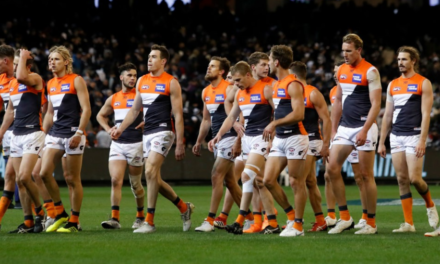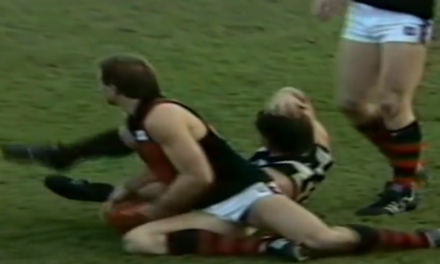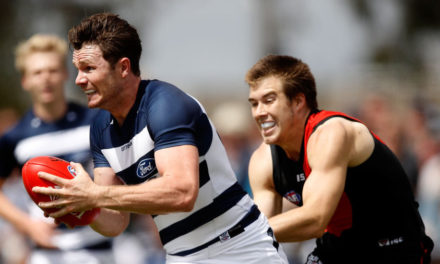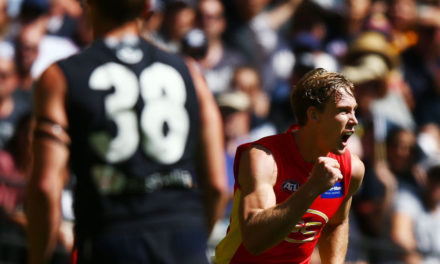Ty Vickery during a VFL game for Hawthorn this year. The former Tiger played just six senior games with the Hawks. Photo: GETTY IMAGES
Draft numbers can only add up to unnecessary pressure
When Ty Vickery announced his AFL retirement on Wednesday, aged just 27, he became the second top 10 pick from the 2008 draft to leave league football prematurely.
While the other, Chris Yarran, retired mainly due to off-field issues, they both represent high-end draft picks who failed to live up to the lofty expectations placed on them.
Every year when the national draft rolls around, AFL fans scour through phantom drafts trying to work out who will be the next superstar to pull on their club’s jumper.
Players in the top 10 of these “wish lists” are often labelled as possessing everything from an “elite kick”, to “match-winning ability” and “strong leadership skills”. But while many high-end draft picks develop into the elite AFL players they are forecast to be, it is by no means guaranteed.
For every Bontempelli, Martin or Dangerfield who set the competition alight, there are names like Morton, Toumpas and Vickery who struggle to make the grade. And perhaps it’s time we stopped putting so much pressure and expectations on first-round draft picks, especially those in the top 10.
The 2008 national draft top 10 is reflective of the mixed bag that results from most AFL drafts.
Vickery and Yarran are now lost to AFL football, while No.1 pick Jack Watts has just been traded to his second club after failing to reach expectations at Melbourne. Stephen Hill, Hamish Hartlett and Daniel Rich have shown glimpses of their talent but have been unable to sustain it over long periods.
That leaves Nic Naitanui, Michael Hurley, Jack Ziebell and Phil Davis as the only top 10 picks from that year who can probably be said to have reached an “elite” level.
Interestingly, three of the best players taken from that draft pool came in the later stages of the draft.
Dayne Beams (29), Dan Hannebery (30) and Rory Sloane (44) are arguably the three best players from that draft, but garnered none of the same attention nor were burdened by the same expectations when they entered the league.
But because players like Watts and Vickery are top 10 picks, it is usually the first thing mentioned about them by fans and the media when they struggle. And those unrealistic expectations turn failed high-end picks into “whipping boys”, which only further harms their careers.
If you actually look at Vickery’s career as a whole, you will find it stacks up quite well compared to many decent AFL players.
A total of 160 goals from 125 games is a solid output, and 36 goals and 150 hitouts in 2011 showed he had the makings of a quality forward/ruckman.
For a number of reasons, he never was able to progress from there into an elite player, and he leaves the game having played just six games in his final season.
Vickery’s fate also highlights that it is the key position early draft picks that struggle the most under this extreme pressure.
They are often expected to start performing on the AFL stage early on in their careers, despite the rule of thumb that young talls take longer to develop.
Because of this, many of the top 10 draft picks who have developed into “whipping boys” are the key forwards – Jarrad Grant, Watts, Vickery, Tom Boyd and Josh Schache just to name a few.
Yet key position players are still usually the most sought after talent come draft time, and first-round draft picks remain a golden currency for AFL clubs.
When it comes to the trade period, clubs are often loath to give up a first-round pick, especially if it is in the top 10. And as a result, the number pick a player is selected with come draft night becomes indicative of the level of scrutiny he will face in the early stages of his career.
The AFL community needs to take the whole AFL draft order caper with a grain of salt, if only to ensure we don’t impose damaging expectations and pressure on an AFL player before he even begins his career.
But also, importantly, because while it will be the top 10 who are given all the media attention when draft night rolls around, there’s every chance it will be a player picked much later in proceedings who shines brightest on the AFL stage.












Perhaps the finger should be pointed at the recruiting/list managers who call the names of Vickery, Watts and other ‘failures’? It must be extremely difficult to assess the potential of especially key position prospects when they’re being graded against less physically-developed peers in TAC Cup and similar competitions. That said, Vickery never looked co-ordinated or particularly athletic and Watts has never looked particularly energised or urgent